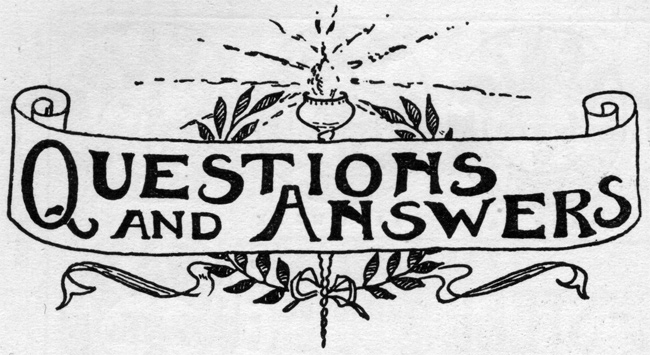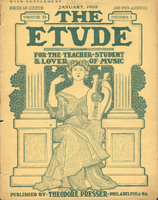
L. C. B.—1. In singing in the key of A minor call “a” la, not do; in singing with numerals instead of syllables, call “a” 6, not 1. If the members of your class have used the numerals 1, 2, 3, 4, etc., with the major scale, they cannot commence the minor scale with 1.
2. If a modulation occurs in the course of a composition, it is just as well to change the syllable names to correspond with the new key. Of course if the modulation be only temporary, it is not necessary to make the change. If it be a somewhat remote key (as E-flat, A-flat, E-major, from C-major), change the syllable names.
W. B. K.—In chorus singing if a phrase be too long to be sung in one breath, let the members of each part divide, some taking breath in the middle of the phrase, others a little later, being careful not to diminish the sustained power of tone, not to join in again with greater energy. A new attack is not to be made.
M. I. Z.—Nohl’s life of Liszt is a useful work. It costs 75 cents. Ramann’s “Franz Liszt, Artist and Man,” two volumes, is a much larger work, and costs $4.50 for both volumes. Mr. James Huneker is at work on a life of Liszt that will be a valuable addition to musical literature.
L. S.—1. A beginner in singing yawns because the deep breathing with the mouth wide open expands the pharynx to a condition similar to that of the yawn.
2. Four-hand playing is a fine means of teaching accurate and steady time-keeping, providing one of the players be a good timist, or if the teacher will beat time for both players, gradually encouraging independent time-keeping.
3. A musical education cannot be considered complete without having devoted some time to the study of history and theory of music, harmony, etc., including a study of piano-playing and piano-music. These things make the musician. Without them one is but a player.
4. The pedal-markings of various editions of the classics may vary somewhat according to the skill of the different editors in the use of the pedal. Some pianists can do more with the pedal than others. The indication given in The Etude are made with care, and we can recommend them as reliable.
H. S.—1. In harmony of six to eight parts, the root is the lowest one of the notes having the same letter name. For example, if C occur three times in the chord of C-E-G, the lowest C is the root of the chord.
2. In the case you mention, in which the accompaniment consists first of a bass note and then several chords, the bass note determines whether the chord is inverted or not; if the root is used as a bass note the chord is in the fundamental position; if the third, it is the first inversion, and so on.
3. In using arpeggios it is not necessary that the notes be resolved strictly, that is, as if each were a note in a separate part. Usually the lowest and highest notes follow the accepted rules of progression.
4. The melody notes are to be considered as a part of the harmony, and should follow the rules for progression, although composers use a freedom that corresponds to the spirit of the rule, not the strict letter. We cannot give you general rules on this point. You need a teacher to criticise your work and show you the application of rules to specific cases.
B. B. B.—1. The violin is tuned in fifths because experience proved that four strings, a fifth apart, was the most useful arrangement. The note of the open string, followed by the stopping of the first three fingers, leads up to the next open string. The matter is not based on acoustics at all. The viola and ‘cello are also tuned in fifths, but the double bass in fourths. Paganini had different tunings of his violin for different pieces, sometimes raising the upper two strings to B-flat and F, respectively.
2. The piano is not tuned by fifths alone; in fact, the best tuners lay stress on the thirds and sixths in laying a good temperament. The next time your tuner calls get him to show you the process, and particularly the “beat.”
B. M.—1. Ambiguity is not a musical term. In its general meaning of “lack of clearness” it might apply to the harmonies of a piece as not indicating clearly the key.
2. Kammenoi-Ostrow is the name of a fashionable watering place near St. Petersburg. The set of pieces by Rubinstein, of this name, purport to be tone portraits of different persons that the composer met at that place.
G. A. W.—Probably no organ-work is so widely used as that of Sir John Stainer. It is concise, logical, and practical, and contains all necessary material. Archer’s work is larger and more elaborate, and is used by many. Either of these works is admirably suited to your purpose.
T. Y.—1. Your young pupil has probably been reading too much in the treble clef. You should have her practice a great deal, each hand separate, until the bass clef is thoroughly mastered. This pupil is not too young to learn, and we would advise you to persevere.
2. Use Landon’s “Method for the Reed Organ.” It is not advisable to attempt teaching reed organ from a piano method.
3. It is sometimes difficult to make good sight-readers of pupils who memorize readily. You should not be discouraged, however, but pursue some special work in sight-reading and introduce a little duet-playing at each lesson. Particularly good practice in sight-reading is to be gained from four-hand music.
In the Virgil “Foundation Method,” Book I, you will find a complete and elaborate set of table-exercises, together with the necessary explanatory text.
A. E. M.—The measure to which you refer at the beginning of the second theme of Chopin’s Nocturne, Op. 37, No. 2, is not superfluous, although it does not appear in some editions. You will find it, however, in standard editions, Kullak and Klindworth both retaining it. In these editions it is the twenty-ninth measure of the piece.



